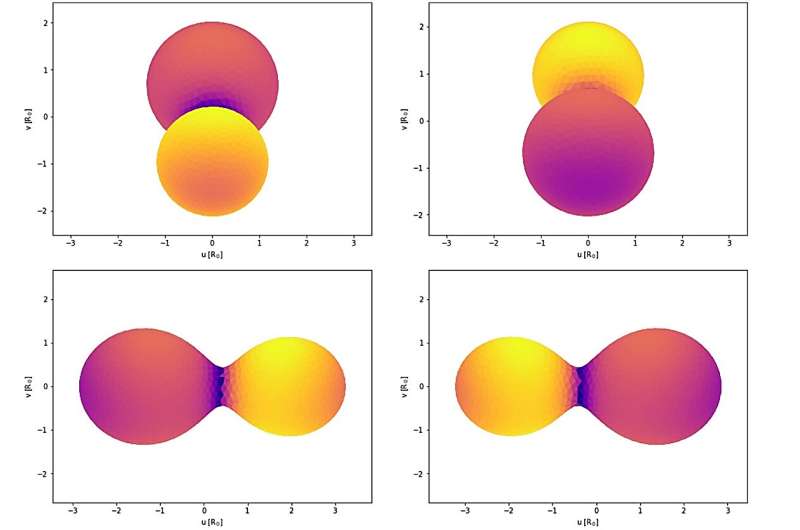August 7, 2023 report
This article has been reviewed according to Science X's editorial process and policies. Editors have highlighted the following attributes while ensuring the content's credibility:
fact-checked
preprint
trusted source
proofread
Research investigates eclipsing binary CSS J003106.8+313347

Using a private observatory, astronomers have performed the first photometric study of a peculiar W UMa-type binary known as CSS J003106.8+313347. Results of the study, published July 27 on the preprint server arXiv, shed more light on the properties of this system.
In general, W Ursae Majoris-type, or W UMa-type binaries (EWs) are eclipsing binaries with a short orbital period (below one day) and continuous light variation during a cycle. They are composed of two dwarf stars with similar temperature and luminosity, sharing a common envelope of material and are thus in contact with one another. Therefore, they are often dubbed "contact binaries."
Located some 4,900 light years away, CSS J003106.8+313347 is an EW with an apparent magnitude of 14.73. The orbital period of the system is estimated to be approximately 0.344 days.
Given that very little is known about CSS J003106.8+313347, a team of astronomers led by Ehsan Paki of the Binary Systems of South and North (BSN) project decided to take a closer look at this system with a private observatory located in Toulon, France. They observed the binary on two nights in late 2022 and acquired nearly 300 images.
"We performed the first photometric study of the CSS J003106.8+313347 W Ursae Majoris (W UMa)-type system based on ground-based observations," the researchers wrote in the paper.
The observations found that the primary star of CSS J003106.8+313347 has an effective temperature of 5,477 K, while the secondary star is 321 K hotter. This finding indicates that the primary and secondary stars have spectral types G8 and G5, respectively.
According to the study, the primary star in the CSS J003106.8+313347 system has a radius of about 1.29 solar radii and its mass is approximately 1.67 solar masses. The star's luminosity was measured to be 1.35 solar luminosities.
When it comes to the secondary component, it turns out that it has a radius of around 1.09 solar radii and a mass of some 1.17 solar masses. The luminosity of this star was found to be at a level of 1.22 solar luminosities.
The Hertzsprung–Russell (HR) diagram of CSS J003106.8+313347 shows that the primary star is above the terminal-age main sequence (TAMS), while the secondary star is between the zero-age main sequence (ZAMS) and TAMS. The astronomers noted that this is consistent with current theories trying to explain the evolution of binary stars.
The observations also found that orbital angular momentum of CSS J003106.8+313347 is 52.08. The authors of the paper concluded that this finding, together with all the new results, suggests that the system is an overcontact binary.
More information: Ehsan Paki et al, The First Photometric Study of the Binary System CSS J003106.8+313347, arXiv (2023). DOI: 10.48550/arxiv.2307.15132
Journal information: arXiv
© 2023 Science X Network





















